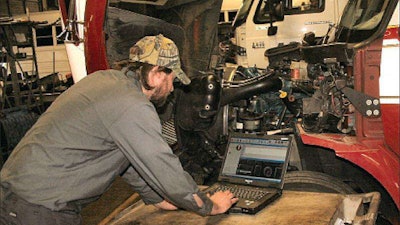
[This article was originally published in 2013 by Trucks, Parts, Service. It has been updated to include more timely information.]
No matter what the position, compensation matters. When you have quality employees, it’s important to have a payment structure in place to keep them — especially in the heavy-duty aftermarket where good technicians are hard to come by.
Today, the two most popular methods for compensating service technicians are a flat-rate system and an hourly system. Each has advantages that can work in your business.
The flat-rate system is gaining popularity in the industry. The system works by charging customers and paying technicians for an equal amount of hours when providing service. If a service provider quotes a fleet two hours to replace two brake shoes, the technician making the repair is then paid two hours in wage to complete the job.
[RELATED: Shops get creative in recruiting, retaining technicians]
The flat-rate system is a positive influence on technicians because it motivates them to complete work in the time billed on repair invoices.
“The [flat-rate] system is a great way to increase productivity, because it allows a service provider to equalize the labor it bills with the labor its technicians provide,” says Mark Martincic with KEA Advisors.
Under the system, if a technician is paid for two hours of work and completes a job in an hour, he is still paid for two hours. However, if a two-hour job takes three hours, he is only paid for two hours.
Katie Hopkins, executive vice president at Truck Centers Inc., says her company has been using a flat-rate system to pay its technicians since the 1980s, citing benefits that speak for themselves.
“I think it motivates [the technicians] to do their work as quickly and effectively as possible,” she says. “It allows them to create their own destiny.”
By knowing in advance what they will be compensated for, Hopkins says her technicians have a goal to work toward. They want to finish jobs on time and provide as much quality work as possible. She adds that her technicians are responsible for errors made in a repair that require extra work, which means a two-hour job that turns into six due to a mistake still results in only two hours of compensation.
The hourly system is the most common payment plan in the heavy-duty industry. The system works by compensating technicians a certain wage per hour for the work they perform.
By paying technicians an hourly rate, a service provider has the flexibility to adjust technicians’ hours based on workload. When things are slow, a technician may work 35 hours a week. When it gets busy, they may work 40 or more.
A technician will be paid overtime (commonly a higher hourly rate) in those cases, but if that allows a facility to complete repairs faster it is still a net positive for the business.
Martincic believes most service providers operate under hourly technician payment plans for that very reason.
“It does allow [them] to manage repairs efficiently because it keeps technicians working on a repair until it’s completed,” he says. But Martincic says an efficient shop isn’t always the result of efficient technicians.
[RELATED: The impact culture has on your job openings]
Quality service managers are what make the hourly payment system really work.
Some service shops give managers the autonomy to run their locations with minimal day-to-day corporate interaction. This allows managers to motivate their technicians in a way they see fit — maximizing profits for the facility and its technicians.
An hourly payment system doesn’t work correctly if technicians aren’t motivated.
The next step in successfully launching a new payment plan is making sure your technicians understand it.
Allowing your payroll and human resources departments to educate technicians about their compensation will make sure everyone is on the same page.
“There has to be communication and consistent engagement between both sides,” Martincic says. “You have to make sure the guys in the shop understand everything.”
Some shop owners try to notify their technicians of any and all financial decisions that affect their paycheck when they occur. The companies also try to keep an open line of communication between technicians and management.
Giving your technicians a little extra to work toward isn’t a bad idea, either. Martincic says goals and rewards programs can help motivate technicians to stay on task, and/or reward quality technicians for doing great work.
Hopkins says Truck Centers’ operating structure features a points system that leads to advancement. Technicians can accrue points for a variety of reasons during the year, and certain point benchmarks allow them the opportunity to move up to different pay grades and into better shift rotations in the dealership.
Each possible step is discussed as well, which keeps technicians abreast of their situation.
“We try to explain to them where they are, and what they can do to stay in one spot or work their way up the scale,” Hopkins says.
Some businesses also use a tiered system to categorize their technicians, and pay half-wages for technicians who take training certification courses and tests in an effort to bump up a tier.
“The guys that really want to get better in their careers do it,” one shop owner says. “We encourage it, because we know how beneficial [the classes] are.”
And the more technicians that make their way up the scale, the better. Because even though that costs money, it’s worth it — a good technician is hard to find.






